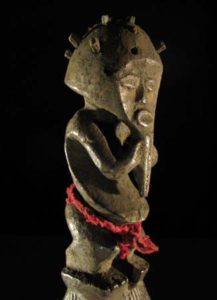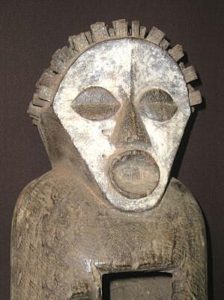Mambila
The Mambila or Mambilla people of Nigeria live on the Mambilla plateau. A small fraction of Mambila migrants left the Mambilla Plateau for the Ndom Plain (also known as the Tikar Plain) on the Cameroon side of the international border as well as in a couple of small villages, such as New Namba, further north towards the towns of Gashaka and Banyo. The preferred ethnonym is spelt Mambila in Cameroon and Mambilla in Nigeria. “Norr” is also used (the word for person in Nigerian dialects of Mambilla).
The Mambila people produced a considerable number of masks and figures that are characterized by a heart-shaped face; red and white pigments were often applied later.
Mambila statues from eastern Nigeria and western Cameroon are carved in the style of a tadep figure. Tadep figures serve as an abode for ancestral spirits and are normally kept on a family altar at a ritual expert’s hut. They are believed to relate to a healing association called Suaga. These wooden ancestor figures have a heart shaped face with enlarged concave eye sockets, and shelf-like shoulders. The figures are usually squat (legs slightly bent with arms brought forward and upward) and disproportional.
Dances celebrating the end of the planting seasons are led by a tribesman wearing a cephalomorphic helmet mask. In turn, the dancer is followed by the retinue of assistants wearing secondary masks in the shape of a dog’s head and a crow’s head.”
Source: Baquart, Jean-Baptiste. The Tribal Arts of Africa. New York: Thames and Hudson Inc. 1998. Print.


